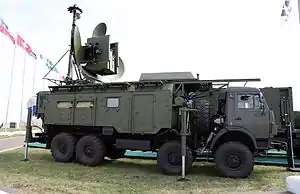Krasukha (electronic warfare system)
The Krasukha (Russian: Красуха; English: Belladonna or Deadly Nightshade) is a Russian mobile, ground-based, electronic warfare (EW) system. This system is produced by the KRET corporation on different wheeled platforms.[1][2] The Krasukha's primary targets are airborne radio-electronics (such as UAVs) and airborne systems guided by radar. The Krasukha has multiple applications in the Russian Armed Forces.[3]
| 1L269 Krasukha-2/4 | |
|---|---|
_Unloaded.jpg.webp)  Krasukha-2/4 at Engineering Technologies 2014 | |
| Type | Electronic Counter Measure system |
| Place of origin | Russia |
| Service history | |
| In service | 2014–present |
| Used by | Russian Federation |
| Production history | |
| Designer | KRET corporation |
| Manufacturer | KRET corporation, BAZ (for wheeled platform of Krasukha-4) |
| Produced | 2010–present |
| Variants | 1L269 Krasukha-2 1RL257 Krasukha-4 |
| Specifications | |
Operational range |
|
Krasukha-2
The Krasukha-2 is intended to jam AWACS at ranges of up to 250 kilometres (160 mi).[3][4] The Krasukha-2 is also able to jam other airborne radars, such as radar guided missiles. The missiles, once jammed, are then provided a false target away from the original to ensure that the missiles are no longer a threat. The Krasukha-2 guards mobile high priority targets such as the 9K720 Iskander SRBM.[3]
Krasukha-4
The Krasukha-4 broadband multifunctional jamming station is mounted on a BAZ-6910-022 four-axle-chassis. Like the Krasukha-2, the Krasukha-4 counters AWACS and other airborne radar systems. The Krasukha-4 has the range effectively to disrupt low Earth orbit (LEO) satellites and can cause permanent damage to targeted radio-electronic devices.[2][5] Ground based radars are also a viable target for the Krasukha-4.[1]
Operational history
Krasukha jammers were reportedly deployed to support Russian forces in Syria.[9] They have reportedly been blocking small U.S. surveillance drones from receiving GPS satellite signals.[10]
In July 2018, an OSCE monitoring mission drone recorded a 1L269 Krasukha-2 among other electronic warfare equipment deployed near Chornukhyne, Ukraine.[11]
Reportedly, Krasukha is operating around the Russian military base at Gyumri in Armenia to counter the use by Azerbaijan of Turkish-made Bayraktar armed drones as well as Israel-made Harop loitering munition (suicide drones).[12]
References
- ""Electronic warfare complex "Krasuha-4""". KRET. Archived from the original on 14 July 2015. Retrieved 4 April 2015.
- "Advanced system to guard Russia from hi-tech surveillance, drone attacks". Russia Today. Retrieved 29 March 2015.
- "1L269 Krasukha-2". Deagel.com. Retrieved 28 March 2015.
- "KRET has fulfilled the state defense order for the delivery of Krasuha-2". Rostek. Retrieved 28 March 2015.
- "Krasukha-4". Deagel.com. Retrieved 28 March 2015.
- Secret-difa3 (13 December 2013). "Tout sur la défense au Maghreb: L'Algérie se dote d'un système de brouillage innovant". Tout sur la défense au Maghreb. Retrieved 13 November 2018.
- دفاع و امنیت (4 August 2019). "سامانه مرموز جنگال در ایران +فیلم". mashreghnews.ir/service/defence-news. Retrieved 4 August 2019.
- https://libya.liveuamap.com/en/2020/18-may-gna-turkish-uav-airstrike-on--electronic-warfare-system. Missing or empty
|title=(help) - Axe, David (21 October 2017). "The jammer can disrupt an enemy's own signals, potentially preventing ground-based controllers from steering their drones via satellite". Vice News.
Russia deployed Krasukha systems to Syria in an effort to form a sort of electronic shield over Russian and allied forces in the country.
- Varfolomeeva, Anna (1 May 2018). "Signaling strength: Russia's real Syria success is electronic warfare against the US". The Defense Post. Retrieved 12 May 2018.
- OSCE. "Latest from the OSCE Special Monitoring Mission to Ukraine (SMM), based on information received as of 19:30, 10 August 2018". osce.org. Retrieved 14 August 2018.
- Bryen, Stephen (26 October 2020). "Russia knocking Turkish drones from Armenian skies". Asia Times. Retrieved 26 October 2020.